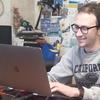Nature Center Walls Stuffed With Straw
October 5, 2023
Throughout the day, a group of over 40 volunteers from around the state worked together to prepare and place straw bales, stuff straw into cracks, and clean up the straw-covered floor. Bales had to be cut to length at the end of the frames, and once placed in the wall, a string and staple system was used to keep them secure as the stack grew. For tight fits, volunteers usually resorted to punching the bales in with their fists, though later, a large wooden mallet nicknamed the “persuader” was put into use. The group finished the job not long after the FRLT-provided lunch of sandwiches, soups, and salads, “record time” for a project like this, according to some FRLT members. The final product looks exceptionally professional despite the primitive material, forming a clean and tightly packed surface, at least when not inspected too closely. The nature center, once open, will provide visitors to the Sierra Valley Preserve with displays showcasing all types of animals, plants, and landscapes native to the Sierra Valley. One interactive exhibit will give visitors insight into birds of the valley, allowing them to point a “sound cone” towards any of the birds on display to hear their calls, facts about their migratory patterns, and when they might be observed locally. Various mammals will also be included in the exhibit. Native fauna, including roots and supporting microorganisms, will be displayed throughout the center. Taking advantage of the building’s thick walls and insulation, a permanent coffee and tea room with a wood stove will allow guests to warm up in the winter, and the exceptional view of the valley from the building’s panoramic windows doesn’t disappoint. The nature center is planned to open sometime before next summer, and FRLT is already recruiting volunteers to keep it open consistently. The center hopes to be a destination for K-12 field trips in the spring and fall, so docents who feel comfortable teaching kids about nature are in demand. Existing outdoor programming, such as birding, will continue after the center opens. If you’re interested in volunteering, contact Jenna Holland, FRLT Public Program Manager, at jholland@frlt.org. Rice straw bales being stackedThe Feather River Land Trust (FRLT) is constructing two new buildings to serve as a new nature center on the northwest side of the Sierra Valley Preserve. Last Saturday, a group of volunteers gathered on a cold and drizzly day to insulate one of those buildings by stuffing its walls with rice straw. While often overlooked, straw bales have similar properties to the more commonly used fiberglass insulation and are a standard part of the California Building Code. Notably, the walls of the nature center’s building are over a foot wide to accommodate the bales with an additional layer of cellulose insulation towards the outside, which gives the walls impressive efficiency. After the straw is placed, stucco will be laid directly on the surface of the hay, sealing the walls and helping draw any remaining moisture from the bales.
Rice straw bales being stackedThe Feather River Land Trust (FRLT) is constructing two new buildings to serve as a new nature center on the northwest side of the Sierra Valley Preserve. Last Saturday, a group of volunteers gathered on a cold and drizzly day to insulate one of those buildings by stuffing its walls with rice straw. While often overlooked, straw bales have similar properties to the more commonly used fiberglass insulation and are a standard part of the California Building Code. Notably, the walls of the nature center’s building are over a foot wide to accommodate the bales with an additional layer of cellulose insulation towards the outside, which gives the walls impressive efficiency. After the straw is placed, stucco will be laid directly on the surface of the hay, sealing the walls and helping draw any remaining moisture from the bales. Volunteers gather for a photo op in front of a near-complete wall
Volunteers gather for a photo op in front of a near-complete wall The under-construction nature center building
The under-construction nature center building
Featured Articles

Storms Bring Heavy Rainfall and Local Disruptions →
December 22, 2025
Sierra County faces power outages and water issues amid heavy rainfall and storm warnings.
215 Animals Seized for Cruelty from Grass Valley Property →
December 22, 2025
Human Remains Found Near South Yuba Bridge in March Identified →
December 17, 2025
Transfer Station Burn Suspended After Community Concerns →
December 16, 2025
Sierra Hardware Plans Extensive Repairs After Flood Damage →
December 8, 2025
